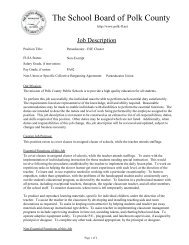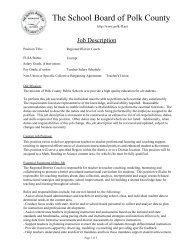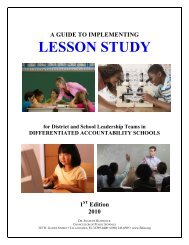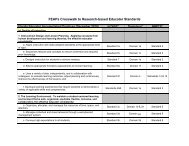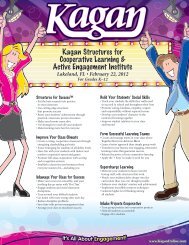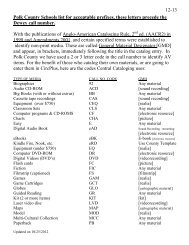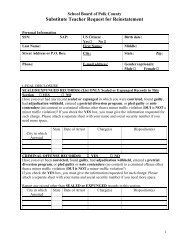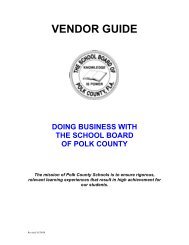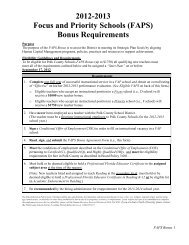Families Building Better Readers - Polk County School District
Families Building Better Readers - Polk County School District
Families Building Better Readers - Polk County School District
You also want an ePaper? Increase the reach of your titles
YUMPU automatically turns print PDFs into web optimized ePapers that Google loves.
<strong>Families</strong> <strong>Building</strong> <strong>Better</strong> <strong>Readers</strong><br />
B L U E P R I N T S F O R S U C C E S S<br />
A FAMILY LITERACY WORKSHOP FOR THE ELEMENTARY GRADES
Table of Contents<br />
Welcome & Introduction<br />
Purpose & Agenda .............................................................................................. 1<br />
How to B-U-I-L-D a <strong>Better</strong> Reader....................................................................... 2<br />
Practice Makes Perfect<br />
1. Choosing the Right Book ............................................................................ 3<br />
2. Guiding Reading Practice............................................................................ 4<br />
Games <strong>Readers</strong> Play<br />
3. Ready, Set, Read!.......................................................................................5-7<br />
4. Three Strikes—You Win.......................................................................... 8-21<br />
5. Word Mysteries..................................................................................... 22-23<br />
Everyday Reading<br />
6. If You See It, Read It.............................................................................. 24-25<br />
7. Talk is Cheap and It Works.........................................................................26<br />
You Are What You Read<br />
8. Books on a Shoestring Budget............................................................ 27-28<br />
9. Picky <strong>Readers</strong> Pick Best..............................................................................29<br />
10. Model Read-Alouds.............................................................................. 30-31<br />
Apply What You’ve Learned!.............................................................................31<br />
Contacts & Resources<br />
Volunteer Florida Foundation..........................................................................32<br />
FBBR Training & Resources...............................................................................32
Welcome!<br />
Thank you for attending this <strong>Families</strong> <strong>Building</strong> <strong>Better</strong> <strong>Readers</strong> TM workshop. By<br />
attending this workshop, you are sending a clear message to your child that his<br />
or her education is important to you. Get ready to have a fun-filled time while<br />
you learn valuable skills for helping your child become the best reader he or she<br />
can be.<br />
About the Workshop<br />
<strong>Families</strong> <strong>Building</strong> <strong>Better</strong> <strong>Readers</strong> TM (FBBR) is a collaborative effort between the<br />
Florida Department of Education’s Just Read, Florida! initiative and the Volunteer<br />
Florida Foundation. Dr. Angela Martin is the author.<br />
Purposes<br />
During this workshop you will:<br />
• learn the importance of consistent reading practice at home;<br />
• learn 10 simple, quick, and effective activities that set your child up for successful reading practice;<br />
• learn how to build your child’s confidence as a reader; and<br />
• gain resources for helping your child practice reading at home.<br />
Workshop Agenda<br />
This workshop lasts about two and a half hours.<br />
PRE-WORKSHOP OPPORTUNITIES (1/2 hour)<br />
OPENING SESSION (1/2 hour)<br />
Sign-in<br />
Refreshments<br />
Meet-and-Greet<br />
Welcome<br />
“How to B-U-I-L-D a <strong>Better</strong> Reader”<br />
Practice Makes Perfect Blueprints<br />
BREAKOUT SESSIONS (1 hour)<br />
Three Sessions @ 20 Minutes Each...<br />
Games <strong>Readers</strong> Play Blueprints<br />
Everyday Reading Blueprints<br />
You Are What You Read Blueprints<br />
WRAP-UP SESSION (1/2 hour)<br />
POST-WORKSHOP ACTIVITIES<br />
F A M I L I E S B U I L D I N G B E T T E R R E A D E R S TM<br />
“The Big Review/Revue” - A Play Starring Your Children<br />
Read-Aloud Demonstration<br />
Concluding Remarks<br />
Door Prizes<br />
Workshop Evaluations<br />
Individual Q & A with <strong>District</strong> Reading Specialists<br />
1
How to B-U-I-L-D a <strong>Better</strong> Reader<br />
• Take the approach of a positive “coach” when working with your child. A child learns best from a parent<br />
who is supportive and uncritical. Your child needs to hear you say again and again, “You can do it!”<br />
• Always set your child up for success to build self-efficacy (personal belief that he or she is capable). This<br />
“I-can” attitude means your child is less likely to quit, even when learning proves difficult.<br />
• Unplug the TV. The time is better spent reading.<br />
• When your child does watch TV, turn on the closed caption option to develop concept of word/word<br />
identification. Encourage the viewing of quality educational programming to build knowledge base and<br />
vocabulary that are necessary for good comprehension.<br />
• Studies show the average child spends only 5 minutes a day reading outside of school hours.<br />
That is simply not enough practice!<br />
• The single most important activity related to eventual success in reading is time spent reading...<br />
practice, practice, practice!<br />
• Can you dedicate at least 20 minutes per day to guide your child’s reading practice? That time adds up to<br />
over 100 hours a year. These hours of practice with your one-on-one help will make a big difference in<br />
your child’s reading ability.<br />
• Keep up the good things you are already doing to help your child in school, such as supervising homework<br />
and reading books together daily!<br />
• During this workshop you will learn 10 simple yet effective strategies for helping your child practice<br />
reading at home.<br />
• Enjoy learning a poem with your child by Shel Silverstein called “Boa Constrictor” (from the book<br />
Where the Sidewalk Ends).<br />
• The school has a role to play and so do you. The school provides initial instruction. Your part is to give<br />
your child opportunities to practice what is learned in school at home. What does it take to become a<br />
good reader? Practice, practice, practice.<br />
• Your decision to make your child’s education a priority makes a big difference. There is a strong<br />
correlation between parent involvement and academic performance. Thank you for demonstrating your<br />
commitment by attending this workshop! We thank you, and your child thanks you.<br />
2<br />
F A M I L I E S B U I L D I N G B E T T E R R E A D E R S TM
PART ONE:<br />
PRACTICE<br />
MAKES PERFECT<br />
Choosing the Right Book<br />
Goal:<br />
Activity:<br />
Supplies:<br />
Choose books for reading practice that are on an appropriate level<br />
for your child.<br />
Reading practice benefits children most when they read books that are not too easy or too hard, but are<br />
just right. This blueprint will give you a way for determining if a book is on the appropriate practice level<br />
for your child.<br />
In this activity you and your child will test out potential texts for reading practice.<br />
Books at varying levels of difficulty<br />
What to Do...<br />
1. Choose a book.<br />
Pick one that you think will be “just right” for your child; a book your child probably won’t find too easy<br />
or too difficult. You can ask your child’s teacher if you need suggestions.<br />
2. Listen to your child read.<br />
Have your child read aloud a short passage from the book.<br />
3. Test accuracy rate.<br />
Out of every ten words your child reads, count how many words are missed. Count a “miss” every time your<br />
child does not read a word correctly or takes longer than three seconds to get it right.<br />
• If your child does not miss any words, that book is too easy for reading practice so test out another book<br />
that is more difficult.<br />
• If your child misses two or more words out of every ten words read, that book is too hard for reading<br />
practice, so test out another book that your child may find easier.<br />
• If your child misses no more than one out of every ten words read, you have successfully found a book that<br />
is “just right” for reading practice. Your child will be able to read 90% of the words accurately and easily<br />
and only have difficulty 10% of the time.<br />
F A M I L I E S B U I L D I N G B E T T E R R E A D E R S TM<br />
3
Guiding Reading Practice<br />
Goal:<br />
Activity:<br />
Supplies:<br />
Help your child get the most out of reading practice.<br />
Parents can help their children improve reading scores by offering consistent opportunities for good<br />
reading practice at home. This blueprint gives you some ideas for helping your child get the most out of<br />
the time he or she spends practicing reading.<br />
In this activity you will use proven strategies to “keep the ball rolling” by effectively guiding your<br />
child’s reading practice.<br />
Locate books, magazines, textbooks, newspapers, etc., that are on the appropriate practice level<br />
for your child (see “Choosing the Right Book” blueprint)<br />
What to Do...<br />
1. Make sure your child benefits from doing easy repeated readings.<br />
This approach is just what it sounds like; the child reads the same easy book over and over again. Easy repeated<br />
readings help children speed up their reading rates, learn new sight words, and develop their abilities to read<br />
in a natural voice using more expression.<br />
2. Make reading practice an enjoyable thinking activity.<br />
Interact with the story as your child reads. Ask questions and react to story events. Summarize events<br />
periodically and seek predictions for what may happen next.<br />
3. Help your child with difficult words.<br />
If your child is stuck on a word for more than three seconds, pronounce the word so your child can maintain<br />
the flow in reading. Letting your child struggle for a long time on a particular word interferes with his or<br />
her ability to understand the text. After you finish reading the book, you can look back at the words your child<br />
missed and review them or practice those words later using flashcards (see “Three Strikes—You Win” blueprint).<br />
4. Try taking turns.<br />
Your child does not have to do all the reading. It is okay to take<br />
turns reading, especially if the story is long. Try these strategies:<br />
• Echo reading<br />
You read a selection using proper expression<br />
and your child mimics you by reading it again.<br />
• Tap-off reading<br />
Each of you indicates when you want your<br />
turn to end by tapping the table or each other.<br />
4<br />
F A M I L I E S B U I L D I N G B E T T E R R E A D E R S TM
PART TWO:<br />
GAMES<br />
READERS PLAY<br />
Ready, Set, Read!<br />
Goal:<br />
Activity:<br />
Supplies:<br />
Help your child to read smoothly and at a steady pace.<br />
Reading smoothly, accurately, and with expression is called fluency. Fluent readers can focus on<br />
the meaning of what they are reading because their brain power is freed up from having to figure<br />
out unknown words.<br />
In this activity you will time your child repeatedly reading the same short passage over several<br />
days. This activity gives your child a chance to learn from mistakes and pick up speed when<br />
reading. Your child will likely read the passage more quickly, smoothly, and accurately each time he<br />
or she rereads it and is timed. This builds your child’s confidence as a reader and ultimately leads to<br />
the ability to concentrate less on individual words while reading and focus more on the meaning<br />
of the whole text.<br />
• Short reading passage from an appropriate level book<br />
(see “Choosing the Right Book” blueprint)<br />
• Stopwatch or clock with a second hand<br />
• Ready, Set, Read! scoring sheet (included with this blueprint)<br />
What to Do...<br />
1. Select a passage.<br />
The passage should not be too easy or too difficult for your child to read. As a general rule of thumb, the<br />
selected passage should be long enough to take your child at least one minute to read it through the first time.<br />
A page from a chapter book may be a good choice in terms of length for a more advanced reader.<br />
2. Do one pre-reading of the passage.<br />
Let your child read the passage to you once without being timed. Help him or her identify any unfamiliar words.<br />
3. Explain the “reading race”<br />
Tell your child you are going to time him or her to see how quickly he or she can read the passage without<br />
making too many mistakes. The goal is only to do his or her personal best. Your child can relax knowing he or<br />
she is not competing against anyone else.<br />
F A M I L I E S B U I L D I N G B E T T E R R E A D E R S TM<br />
5
Ready, Set, Read! (continued)<br />
4. Start the “reading race.”<br />
Remind your child to read “quickly but carefully” and then start the race by announcing, “Ready, Set, Read!”<br />
Time how long (in seconds) it takes him or her to read the entire passage.<br />
5. Supply your child any missed or unfamiliar words.<br />
If your child makes a mistake or cannot read a word within three seconds, give your child that word so<br />
he or she can quickly move on. Keep a count of how many words were missed and review those<br />
missed words once the timing is over. Consider using those missed words for the flashcards you<br />
make for the “Three Strikes—You Win” blueprint.<br />
6. Determine the “score.”<br />
You determine the score by adding the number of words missed to the total number of<br />
seconds it took your child to read the passage. Record that number on a Ready, Set,<br />
Read! scoring sheet (included on the next page).<br />
7. Have your child read the same passage again the next day.<br />
Challenge your child to read the passage again even more quickly and carefully.<br />
Time and record the new (and most likely improved) score.<br />
8. Repeat this process up to five times using the same reading passage.<br />
Do no more than two timed readings a day. When your child can read that passage<br />
smoothly, quickly, and with very few errors, you can select a different passage and<br />
begin a new series of timed readings.<br />
Notes<br />
__________________________________________________________________________________________________<br />
__________________________________________________________________________________________________<br />
__________________________________________________________________________________________________<br />
__________________________________________________________________________________________________<br />
__________________________________________________________________________________________________<br />
__________________________________________________________________________________________________<br />
__________________________________________________________________________________________________<br />
__________________________________________________________________________________________________<br />
__________________________________________________________________________________________________<br />
__________________________________________________________________________________________________<br />
__________________________________________________________________________________________________<br />
__________________________________________________________________________________________________<br />
6<br />
F A M I L I E S B U I L D I N G B E T T E R R E A D E R S TM
Ready, Set, Read! Scoring Sheet<br />
Title of passage: SAMPLE PASSAGE Start Date: DATE<br />
1 st 2 nd 3 rd 4 th 5 th<br />
62/4<br />
58/3<br />
55/2<br />
50/1<br />
45/1<br />
66<br />
61<br />
57<br />
51<br />
46<br />
Title of passage:<br />
Start Date:<br />
1 st 2 nd 3 rd 4 th 5 th<br />
Title of passage:<br />
Start Date:<br />
1 st 2 nd 3 rd 4 th 5 th<br />
Title of passage:<br />
Start Date:<br />
1 st 2 nd 3 rd 4 th 5 th<br />
Title of passage:<br />
Start Date:<br />
1 st 2 nd 3 rd 4 th 5 th<br />
F A M I L I E S B U I L D I N G B E T T E R R E A D E R S TM<br />
7
Three Strikes, You Win!<br />
Goal: <br />
Increase the number of sight words your child can read quickly and easily.<br />
Sight words are ones that make up 50- 80% of everyday conversation or reading (such as “the”,<br />
“because”, or “want”). When a child knows a word by “sight,” it means he or she can read that word<br />
quickly and without having to think about it or sound it out. Knowing a lot of sight words allows your<br />
child to read smoothly and evenly so he or she can focus on reading for understanding rather than<br />
struggling to figure out individual words.<br />
Activity:<br />
Supplies:<br />
In this activity you will be making and using flash cards to help your child learn sight words<br />
through a motivational game. Flash cards can also be used to help your child commit<br />
vocabulary words, spelling words, math facts, and other such items to memory.<br />
• Blank index cards<br />
• Marker<br />
• Word list appropriate for your child<br />
• Pre-printed flash card set (we’ve included this set to get you started)<br />
What to Do...<br />
1. Start with a list of words that your child needs to work on.<br />
Ask for a list from his or her teacher, use words found in the sight word list included with this blueprint, or<br />
use words you’ve noted your child doesn’t know well when doing other reading activities.<br />
2. Print each word on a separate index card in a way so it resembles book print.<br />
3. Tell your child you will be playing a game called “Three Strikes—You Win.”<br />
Unlike baseball, in this game when a player gets three strikes, the player is a winner. Every time your child reads<br />
a word correctly, you will put a strike (an “x”) on the back of that word card. Once a word card has three strikes,<br />
your child wins that card, and it is removed from the deck.<br />
4. Hold a stack of cards up to your child.<br />
Don’t make the stack too thick or it may overwhelm your child (rule of thumb - your child should be able to go<br />
through entire stack in just a few minutes). Ask your child to read the word that faces him or her.<br />
• If your child can’t read the word, help him or her sound it out or, if it doesn’t sound out, look for a way to<br />
remember it. Move the card to the back of the stack.<br />
• If your child reads the word, but does so with difficulty (i.e. takes longer than three seconds), praise him or<br />
her for the success and move the card to the back of the stack.<br />
• If your child reads the word quickly and easily, mark an “x” on the back of the card. Tell your child that’s<br />
“one strike” and all he or she needs is two more strikes to win.<br />
5. Continue working with your flash card deck in this manner.<br />
When you are finished going through the entire deck, go back through the word cards that your child missed<br />
and have him or her spell each one to you aloud.<br />
6. You can go through the card deck several times a day, but mark an “x” only once per day.<br />
7. When a word card gets three “strikes” on the back, celebrate!<br />
Remove that card from the deck and replace it with a new and different word card from your list.<br />
8<br />
F A M I L I E S B U I L D I N G B E T T E R R E A D E R S TM
Three Strikes, You Win! (continued)<br />
Sight words are the most common words found in texts. If your child memorizes these words, it saves him or her the<br />
time it would take to sound them out when reading. In addition, some of these words cannot be sounded out because<br />
they do not follow the usual rules. These words must therefore be memorized.<br />
Pre-Primer<br />
Primer<br />
First Grade<br />
Second Grade<br />
Third Grade<br />
a<br />
and<br />
away<br />
big<br />
blue<br />
can<br />
come<br />
down<br />
find<br />
for<br />
funny<br />
go<br />
help<br />
here<br />
I<br />
in<br />
is<br />
it<br />
jump<br />
little<br />
look<br />
make<br />
me<br />
my<br />
not<br />
one<br />
play<br />
red<br />
run<br />
said<br />
see<br />
the<br />
three<br />
to<br />
two<br />
up<br />
we<br />
where<br />
you<br />
all<br />
am<br />
are<br />
at<br />
ate<br />
be<br />
black<br />
brown<br />
but<br />
came<br />
did<br />
do<br />
eat<br />
four<br />
get<br />
good<br />
have<br />
he<br />
into<br />
like<br />
must<br />
new<br />
no<br />
now<br />
on<br />
our<br />
out<br />
please<br />
pretty<br />
ran<br />
ride<br />
saw<br />
say<br />
she<br />
so<br />
soon<br />
that<br />
there<br />
they<br />
this<br />
too<br />
under<br />
want<br />
was<br />
well<br />
went<br />
what<br />
after<br />
again<br />
an<br />
any<br />
as<br />
ask<br />
by<br />
could<br />
every<br />
fly<br />
from<br />
give<br />
going<br />
had<br />
has<br />
her<br />
him<br />
his<br />
how<br />
just<br />
know<br />
let<br />
live<br />
may<br />
of<br />
old<br />
once<br />
open<br />
over<br />
put<br />
round<br />
some<br />
stop<br />
take<br />
thank<br />
them<br />
then<br />
think<br />
walk<br />
were<br />
when<br />
always<br />
around<br />
because<br />
been<br />
before<br />
best<br />
both<br />
buy<br />
call<br />
cold<br />
does<br />
don’t<br />
fast<br />
first<br />
five<br />
found<br />
gave<br />
goes<br />
green<br />
its<br />
made<br />
many<br />
or<br />
off<br />
pull<br />
read<br />
right<br />
sing<br />
sit<br />
sleep<br />
tell<br />
their<br />
these<br />
those<br />
upon<br />
us<br />
use<br />
very<br />
which<br />
why<br />
work<br />
wish<br />
would<br />
write<br />
your<br />
about<br />
better<br />
bring<br />
carry<br />
clean<br />
cut<br />
done<br />
draw<br />
drink<br />
eight<br />
fall<br />
far<br />
full<br />
got<br />
grow<br />
hold<br />
hot<br />
hurt<br />
if<br />
keep<br />
kind<br />
laugh<br />
long<br />
light<br />
much<br />
myself<br />
show<br />
six<br />
start<br />
ten<br />
today<br />
together<br />
try<br />
warm<br />
never<br />
only<br />
own<br />
pick<br />
seven<br />
shall<br />
show<br />
small<br />
white<br />
who<br />
will<br />
with<br />
yellow<br />
F A M I L I E S B U I L D I N G B E T T E R R E A D E R S TM<br />
9
10<br />
F A M I L I E S B U I L D I N G B E T T E R R E A D E R S TM
F A M I L I E S B U I L D I N G B E T T E R R E A D E R S TM<br />
11
12<br />
F A M I L I E S B U I L D I N G B E T T E R R E A D E R S TM
F A M I L I E S B U I L D I N G B E T T E R R E A D E R S TM<br />
13
14<br />
F A M I L I E S B U I L D I N G B E T T E R R E A D E R S TM
F A M I L I E S B U I L D I N G B E T T E R R E A D E R S TM<br />
15
16<br />
F A M I L I E S B U I L D I N G B E T T E R R E A D E R S TM
F A M I L I E S B U I L D I N G B E T T E R R E A D E R S TM<br />
17
18<br />
F A M I L I E S B U I L D I N G B E T T E R R E A D E R S TM
F A M I L I E S B U I L D I N G B E T T E R R E A D E R S TM<br />
19
20<br />
F A M I L I E S B U I L D I N G B E T T E R R E A D E R S TM
F A M I L I E S B U I L D I N G B E T T E R R E A D E R S TM<br />
21
Word Mysteries<br />
Goal:<br />
<br />
Activity:<br />
Supplies:<br />
Help your child understand the<br />
relationship between the sounds of<br />
spoken language and the letters that<br />
represent those sounds in writing.<br />
When a child has a good grasp of the way letters go<br />
together to make different sounds in words,<br />
he or she can spell and sound out unfamiliar words<br />
more accurately.<br />
In this activity you will give your child sound clues<br />
to determine what object you have hidden.<br />
• Interesting object(s) to hide<br />
• Paper and pencil<br />
What to Do...<br />
<br />
1. Find an interesting object to share (calculator, prism, magnet, feather, seashell, etc.).<br />
<br />
2. Hide the object nearby.<br />
<br />
3. Tell your child you will be playing a game together like “Hide and Seek” called “Word Mysteries.”<br />
When he or she figures out the name of the hidden object based on clues you give, your child gets to seek and<br />
find the object.<br />
<br />
4. Tell your child the first sound in the name of the object.<br />
Give one sound (like b) or one sound unit (like th) at a time. Make sure you do not add sounds on the ends of<br />
letter sounds that aren’t there (e.g., saying buh instead of simply b). Have your child guess what the hidden<br />
object could be using your first clue.<br />
<br />
5. Once the guess is made, ask what sound should be next if the guess is correct.<br />
Try exaggerating the sounds by singing out the word so your child can hear individual sounds more easily.<br />
<br />
6. Next, write the correct letter(s) for the next sound in the word.<br />
If the correct letter(s) matches your child’s guess, move on to the next letter. If it doesn’t match his guess, ask<br />
for a new guess of what the word might be and test the next sound in the new guess.<br />
<br />
7. Follow this process until the entire word is spelled out.<br />
Once complete, let your child seek the object. Talk together about the object and what makes it interesting<br />
(see “Talk is Cheap and It Works” blueprint for ideas).<br />
22<br />
F A M I L I E S B U I L D I N G B E T T E R R E A D E R S TM
Word Mysteries (continued)<br />
Here is one example of playing this game:<br />
a. “I’m going to write the letter that makes the first sound you hear in the name of the hidden object.”<br />
p<br />
b. “What might the word be?” (Child says “painting.”) “If the word is painting, what is the next<br />
sound you hear in that word after the p sound?” (Child makes the long a sound.) “That’s right. So<br />
I should write the letters ai next IF the word is painting.” (Notice that the a and i were presented<br />
together because these two letters make the next sound together - they are a sound unit.)<br />
pr<br />
c. “I did not write ai, instead I added an r, so the hidden object cannot be a painting. What<br />
might the object be now that you know the first two sounds are pr?” (Child says “present.”)<br />
“If the object I have hidden is a present, what would the next sound be?” (Child makes a short<br />
e sound.) “Okay, so if the object is a present, I’ll need to write an e, let’s test that one out.”<br />
pri<br />
d. “Since I did not add an e, we now know the object cannot be a present.”<br />
e. Continue in this way until the word prism is completely spelled out. “You’ve figured out<br />
the hidden object is a prism. I’ll give you the clues of ‘hot’ and ‘cold’ to help you find it.”<br />
(Child finds the prism.) “Let’s take a closer look. See how the prism reflects all the colors of<br />
the rainbow when I hold it up to the light?” (Continue conversation about the object.)<br />
prism<br />
Notes<br />
__________________________________________________________________________________________________<br />
__________________________________________________________________________________________________<br />
__________________________________________________________________________________________________<br />
__________________________________________________________________________________________________<br />
__________________________________________________________________________________________________<br />
__________________________________________________________________________________________________<br />
__________________________________________________________________________________________________<br />
__________________________________________________________________________________________________<br />
__________________________________________________________________________________________________<br />
__________________________________________________________________________________________________<br />
__________________________________________________________________________________________________<br />
__________________________________________________________________________________________________<br />
__________________________________________________________________________________________________<br />
__________________________________________________________________________________________________<br />
__________________________________________________________________________________________________<br />
__________________________________________________________________________________________________<br />
23<br />
F A M I L I E S B U I L D I N G B E T T E R R E A D E R S TM
PART THREE:<br />
EVERYDAY<br />
READING<br />
If You See It, Read It!<br />
Goal: <br />
Activity:<br />
Supplies:<br />
Give your child practice reading real-world texts for real purposes.<br />
Good reading material for children can be found in other places besides just books. In fact, much of the<br />
reading we do each day in the real world is not from books at all. Opportunities for your child to use<br />
reading for real-world purposes can be found in abundance during your daily routines and will motivate<br />
your child to do well in school.<br />
In this activity your child will practice reading material other than books and textbooks. Think of all<br />
the things you often read during any given day (phonebook, recipe, advertisement, letter from a<br />
friend, food label, TV guide, road signs, etc.). When your child reads these same things in search of<br />
useful information, he or she gains an appreciation for the connection between school and the real<br />
world.<br />
Print you often see and use in your daily life, such as a newspaper, magazine, menu, cereal box,<br />
phonebook, etc.<br />
What to Do...<br />
As you go through your day together, “assign” your child real-world reading tasks. You may have to show your<br />
child how to find the information he or she is seeking at first, but soon your child will be able to do it<br />
independently. A few ideas follow, but the possibilities for finding and using everyday reading materials for<br />
practice are practically unlimited.<br />
24<br />
F A M I L I E S B U I L D I N G B E T T E R R E A D E R S TM
If You See It, read It! (continued)<br />
1. What is right in front of your child’s nose most mornings?<br />
A cereal box.<br />
What are the ingredients? How many ounces are in a serving? Ask<br />
your child to read and find out. Read directions to fill out the<br />
mail-in forms for any free prizes offered.<br />
2. What is black and white and “read” all over? A newspaper!<br />
Give your child real purposes for reading out of the newspaper:<br />
• Does he or she want to see a movie? Have your child read<br />
the movie listings, and then find and select a time you<br />
might attend.<br />
• Playing in a little league game this weekend?<br />
Have your child check the weather forecast.<br />
• What’s on television tonight? Read the TV Guide to find out.<br />
• You’ll both find the comic strips or funny<br />
pages entertaining. Read them together.<br />
• Be a role model for your child by reading things like the<br />
newspaper in front of him or her.<br />
3. What’s good to eat at your local drive-thru?<br />
Let your child read the menu and order within the given budget by finding the “best deal.”<br />
4. Want to order a pizza?<br />
It’s only a phone call away. Ask your child to find the number in the phonebook.<br />
5. Have your child write and mail a letter to a friend or relative.<br />
Watch as he or she opens the reply letter and reads it enthusiastically.<br />
6. Time for dinner?<br />
Have your child read the recipe aloud as you follow the directions. Try letting your child follow the sequential<br />
directions and with your supervision make cookies or something else yummy from an easy box mix.<br />
7. Don’t forget a nightly bedtime story…a memory your child will treasure forever.<br />
Notes<br />
__________________________________________________________________________________________________<br />
__________________________________________________________________________________________________<br />
__________________________________________________________________________________________________<br />
__________________________________________________________________________________________________<br />
__________________________________________________________________________________________________<br />
__________________________________________________________________________________________________<br />
__________________________________________________________________________________________________<br />
__________________________________________________________________________________________________<br />
__________________________________________________________________________________________________<br />
__________________________________________________________________________________________________<br />
25<br />
F A M I L I E S B U I L D I N G B E T T E R R E A D E R S TM
Talk is Cheap, and it Works<br />
Goal:<br />
Activity:<br />
Supplies:<br />
Build your child’s knowledge base and<br />
vocabulary through rich conversation.<br />
To be able to read and understand a word in a sentence<br />
it is helpful if a child has heard that word before and has<br />
some notion of what it means. Children most often pick<br />
up words like this through conversations they have had<br />
with adults.<br />
In this activity you will engage your child in<br />
rich conversation.<br />
Topics, events, objects, stories, ideas, feelings to discuss<br />
What to Do...<br />
Spend quality time conversing with your child every day. You can easily do this while you are going about your daily<br />
routines. Try the following strategies:<br />
1. Eat dinner as a family.<br />
Research reveals that children who sit down at the dinner table with their families are better readers than those<br />
that don’t. What’s going on at the dinner table? Conversation. Children who regularly converse with adults are<br />
exposed to tens of thousands of more words per year than those who don’t.<br />
2. When conversing with your child try the following strategies:<br />
• Expand on your child’s statements.<br />
Child says, “Want juice.” You rephrase and respond using more developed sentence structure, “Yes, you would<br />
like to drink some apple juice.”<br />
• Describe what you are doing.<br />
When talking with younger children, think of yourself as Howard Cosell, giving a play-by-play of the activities<br />
you or your child are doing: “You are stacking the blocks. You made a tower. Oh the tower tumbled down!”<br />
• Describe things you see.<br />
Tell what you know/understand: “Look at this tiny roly-poly. See how it balls itself up for protection?”<br />
• Use vivid words for descriptions.<br />
“This sugared candy is tangy but sweet.”<br />
• Expose your child to correct terminology.<br />
“Can you see the antennae on top of this insect’s head?”<br />
“Watch my measuring tape retract when I press this button.”<br />
• Ask questions that require your child to think deeply.<br />
“How do you think a butterfly is like a growing child?”<br />
3. Don’t feel badly if you don’t know all the answers to your child’s questions.<br />
“I’m not sure why rainbows have different colors, let’s find a book to learn more about that together.”<br />
26<br />
F A M I L I E S B U I L D I N G B E T T E R R E A D E R S TM
PART FOUR:<br />
YOU ARE WHAT<br />
YOU READ<br />
Books on a Shoestring Budget<br />
Goal:<br />
Activity:<br />
Supplies:<br />
Find inexpensive and free reading materials for practice.<br />
The idea of purchasing books for your child’s home library is wonderful but can also prove expensive.<br />
There are many places you can go to find inexpensive or free books and magazines to stock your child’s<br />
book shelf without breaking the bank.<br />
In this activity you will gain the resources and skills for finding good affordable reading material.<br />
Library card, classified section of newspaper, phone, book club flyers, etc<br />
What to Do...<br />
<br />
There are many places you can go for inexpensive or free reading material. Try the following suggestions:<br />
1. Apply for a library card at your local library.<br />
This is your “homework” for this workshop-- Call your local library and fill in the following information:<br />
• Where are the nearest libraries to me?<br />
• How do I apply for a library card so that I can check out<br />
free books?<br />
• What days and times does the library offer a story<br />
hour or other special programs for my child?<br />
• Special Note: you may also call your child’s school library<br />
to see if any hours are open to families, and if they have any<br />
scheduled book fairs.<br />
2. Get book deals at yard sales.<br />
Search for yard sales in the classified section of your newspaper<br />
that include children’s books. You can often pick up good books<br />
at very reasonable prices.<br />
F A M I L I E S B U I L D I N G B E T T E R R E A D E R S TM<br />
27
Books on a Shoestring Budget (continued)<br />
3. Purchase books at used book stores.<br />
4. Ask local professional offices for their “old” magazines.<br />
Call and ask what they do with outdated magazines in their waiting<br />
rooms. Explain you are looking for good reading material for your child<br />
and offer to pick up their unwanted magazines when it is convenient.<br />
5. Consider buying from a book club.<br />
Consider purchasing books from the different book club flyers sent<br />
home by your child’s teacher. The prices for books offered in these<br />
flyers are typically much lower than what you will find them for in<br />
book stores.<br />
6. Reading materials “to go.”<br />
Stop by fast-food places or restaurants to pick up children’s menus<br />
that feature reading games.<br />
7. Ask a teacher.<br />
Ask your child’s teacher for any free materials that he or she may<br />
receive that promote family literacy.<br />
8. Give the lifelong gift of reading.<br />
Ask relatives to purchase a book instead of a toy next time they want<br />
to give your child a gift. The gift of reading lasts a lifetime while toys<br />
often end up in the bottom of a closet.<br />
9. Brainstorm.<br />
What are some of your own ideas for finding free or inexpensive<br />
reading materials?<br />
Notes<br />
______________________________________________________________________<br />
______________________________________________________________________<br />
______________________________________________________________________<br />
______________________________________________________________________<br />
______________________________________________________________________<br />
______________________________________________________________________<br />
______________________________________________________________________<br />
______________________________________________________________________<br />
______________________________________________________________________<br />
______________________________________________________________________<br />
______________________________________________________________________<br />
______________________________________________________________________<br />
28<br />
F A M I L I E S B U I L D I N G B E T T E R R E A D E R S TM
Picky <strong>Readers</strong> Pick Best<br />
Goal:<br />
Activity:<br />
Supplies:<br />
Learn how to select high-interest reading<br />
material to motivate even the most<br />
reluctant readers.<br />
It is sometimes difficult to motivate children to practice<br />
reading. When you make sure your child has reading<br />
material available on topics he or she especially enjoys,<br />
wanting to practice reading becomes a given.<br />
In this activity you will determine your child’s specific<br />
interests by asking a series of questions. You will also<br />
take notes about books presented that you think may<br />
interest your child.<br />
• List of questions (included below)<br />
• Books of high interest to your child<br />
What to Do...<br />
1. Determine what topics interest your child.<br />
Ask your child the questions listed below. Use his or her answers to help you select books that your child will find<br />
the most appealing.<br />
• What do you know a lot about?<br />
• What do you want to learn more about?<br />
• What kinds of books or magazines or other reading material do you enjoy reading most? Why?<br />
• If you could choose only three books from the library what would they be about? Why those topics?<br />
• What book topics do you least enjoy? Why?<br />
2. Periodically ask the same set of questions to see if his or her areas of interest have changed.<br />
If they have, find new reading materials to match your child’s ever-changing new interests.<br />
3. Know what books are popular with kids.<br />
Use the space below to make notes about books presented during this workshop that may interest your child.<br />
Book List<br />
__________________________________________________________________________________________________<br />
__________________________________________________________________________________________________<br />
__________________________________________________________________________________________________<br />
__________________________________________________________________________________________________<br />
__________________________________________________________________________________________________<br />
__________________________________________________________________________________________________<br />
__________________________________________________________________________________________________<br />
__________________________________________________________________________________________________<br />
29<br />
F A M I L I E S B U I L D I N G B E T T E R R E A D E R S TM
Model Read Alouds<br />
Goal:<br />
Activity:<br />
Supplies:<br />
Learn how to model for children what<br />
effective readers do through<br />
interactive read-alouds.<br />
The National Reading Panel states that the single<br />
best predictor of children’s eventual success in<br />
reading is how often their parents read to them.<br />
Children learn a lot about what effective readers do<br />
from watching and listening to adults read to and<br />
with them.<br />
In this activity you will model effective reading<br />
practices while reading aloud to your child.<br />
Good readers actively think about what they<br />
read. They sometimes pause to summarize what<br />
they have read, ask themselves questions, make<br />
predictions, and test those predictions as they read further along. They also read with expression<br />
and use their imaginations to make story lines more vivid.<br />
Appealing non-fiction and fiction books that can be on a higher level than your child<br />
can read alone.<br />
What to Do...<br />
1. Select a good book from recommended booklists. See our list online by going to www.justreadflorida.org<br />
and clicking on the <strong>Families</strong> <strong>Building</strong> <strong>Better</strong> <strong>Readers</strong> TM link. You can also ask your librarian or your child’s<br />
teacher for a suggestion. Preview the book ahead of time so you can plan how you will make the reading<br />
interactive.<br />
2. Talk about what you will be reading before you begin the book.<br />
3. Introduce the book by reading the title and author’s name. Note details about the cover illustration. Ask your<br />
child to predict (not guess) what the story might be about based on the title and picture.<br />
4. Read the book at a fairly quick pace using a lot of expression. For example, when the story becomes serious,<br />
slow down and read thoughtfully. When something funny happens, laugh. Make up interesting voices for each<br />
of the characters. This keeps your child’s attention and teaches your child to visualize what is read in the mind -<br />
a strategy effective readers use to improve understanding.<br />
5. Explain unfamiliar words. When you come across a word your child may not know, pause briefly to explain.<br />
Challenge your child to use the pictures on the page or other words in the surrounding sentence(s) to figure<br />
out what the word may mean.<br />
6. Help your child connect to the story. Point out interests, characteristics, or feelings he or she may share with<br />
the characters.<br />
30<br />
F A M I L I E S B U I L D I N G B E T T E R R E A D E R S TM
Model Read-Alouds (continued)<br />
7. Do stop and ask questions, but don’t go overboard. Use places in the story where there is a natural pause<br />
to stop and ask your child questions that will guide him or her toward understanding. Point out clues that can<br />
be used from what you’ve read so far that might be helpful in making predictions (not guesses).<br />
8. Ask your child to participate in the reading in some way. You may ask your child to do things like read a<br />
certain character’s lines or read all the repetitive parts of the story (e.g., word phrases that occur again and<br />
again such as, “Run, run as fast as you can… you can’t catch me I’m the Gingerbread Man!”).<br />
9. After you have finished the story, review. Flip back through the pages and talk about what you read<br />
together. Talk about interesting things you learned or questions your child may have or ones that are left<br />
unanswered by the author. Give your child the opportunity to retell the story or parts of the story using his or<br />
her own words.<br />
10. Extend the reading experience. Relate the reading to your daily lives in some way. You might cook food<br />
related to the story, talk with someone who knows more about the subject, do a related art project, or write a<br />
pretend letter to one of the characters.<br />
Apply what you’ve learned!<br />
Parents- You’ll have a chance to show off what you’ve learned during this workshop. At the end of this workshop,<br />
you’ll watch a trainer do a read-aloud demonstration. During that demonstration, we challenge you to identify all<br />
ten tips for reading aloud listed in the Model Read-Alouds blueprint.<br />
Here’s some information on the book that you and your children will enjoy during this final activity: Sam’s<br />
Sandwich by David Pelham. Synopsis - Sam makes his sister a sandwich. His sister Samantha offers him a bite, but<br />
Sam knows something Samantha doesn’t know; he’s put some unusual ingredients inside. Do you think Sam will<br />
take a bite?<br />
For our complete list of great read-aloud books, visit our website at www.justreadflorida.org.<br />
Notes<br />
__________________________________________________________________________________________________<br />
__________________________________________________________________________________________________<br />
__________________________________________________________________________________________________<br />
__________________________________________________________________________________________________<br />
__________________________________________________________________________________________________<br />
__________________________________________________________________________________________________<br />
__________________________________________________________________________________________________<br />
__________________________________________________________________________________________________<br />
__________________________________________________________________________________________________<br />
__________________________________________________________________________________________________<br />
__________________________________________________________________________________________________<br />
__________________________________________________________________________________________________<br />
31<br />
F A M I L I E S B U I L D I N G B E T T E R R E A D E R S TM
Contacts<br />
Volunteer Florida Foundation<br />
401 South Monroe Street Elliot <strong>Building</strong><br />
Tallahassee, FL 32301<br />
Phone: 800-825-3786<br />
fbbrinfo@volunteerflorida.org<br />
Training & Instructional Design<br />
Anita S. Rodgers, M.Ed.<br />
anita.rodgers@vfffund.org<br />
Lead Trainer & Program Developer<br />
Dr. Angela Martin<br />
angela.martin@vfffund.org<br />
FBBR Website<br />
www.justreadflorida.com/fbbr.asp<br />
<strong>Families</strong> <strong>Building</strong> <strong>Better</strong> <strong>Readers</strong> is a Florida Department of Education program, managed by<br />
Volunteer Florida Foundation and funded by Just Read, Florida!<br />
32<br />
F A M I L I E S B U I L D I N G B E T T E R R E A D E R S TM
R E V I S E D 9 / 2 0 0 6



